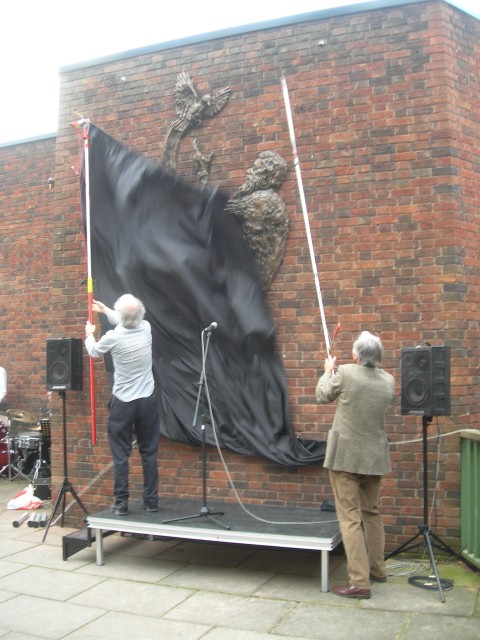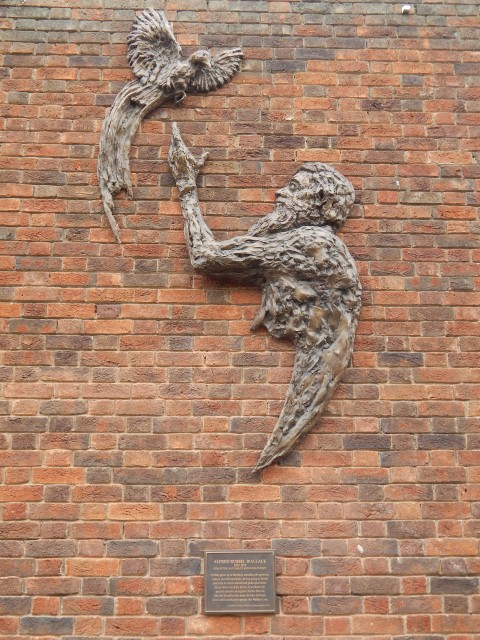On Saturday October 18 a wonderful new sculpture of Wallace was unveiled in Hertford, UK, the town where Wallace went to school. It was created by talented local sculptor Rodney Munday who had won a public competition to produce the work.
The sculpture was the brainchild of Hertford Civic Society and Malcolm Ramsay of the Society oversaw the project from beginning to end.
The unveiling attracted a crowd of about 60 local residents, and a number of local dignitaries, such as the town's mayor, were in attendance. George Beccaloni, chairman of the Wallace Fund, was asked to give a speech and unveil the piece, which is fixed to the exterior wall of Hertford Theatre. After the unveiling Rodney Munday gave a talk which is reproduced below.
The audience.
Jazz band from Wallace's old school (now Hertford Grammar School), and Malcolm Ramsay (front).
George (center) delivering he speech, flanked by Malcolm Ramsay (left) and Rodney Munday (right)
wielding pruners.

The sculpture is revealed with the help of the pruners!

Rodney's magnificent sculpture.
Rodney (left) and Malcolm (right) with the sculpture.
Rodney Munday's speech:
"This has been a fascinating project because of the remarkable personality of Wallace himself. Quite apart from his groundbreaking work on evolutionary theory, he was a polymath of Renaissance proportions who achieved his extraordinary eminence in spite of disadvantaged beginnings, having to leave school early because of family financial difficulties. If this sculpture encourages people to take a closer look at the man it will have been a success. I would heartily recommend his autobiography “My Life” as well as his more famous “Malay Archipelago” which deals with the period when his ideas on evolution came to him.
Producing a sculpture of someone from the past is a little like writing a historical novel. In order to produce anything other than the blandest of portraits, you have to try to get inside the person, to understand and empathise – and then produce something which expresses both the personality and its historical context.
One of the most fascinating historical issues relating to Wallace was that he developed his ideas on natural selection at much the same time as Darwin, but independently of him. Like most (indeed, perhaps all) amazing discoveries, however, their work did not come out of a vacuum, and with hindsight, we can see how the time was ripe for them –which is in no way to disparage their tremendous achievement. In my sculpture, Wallace is reaching out for a bird of paradise, a creature which fascinated him and of which he collected many specimens to send back to England. But it seemed to me that the bird with which he was pre-occupied at the time of his discovery could also be seen as symbolic of his ideas on evolution, which were, as it were “in the air” and ready to be plucked from it by someone with remarkable perceptive capacity. And that idea has had the happy consequence of enabling me to develop a design in which the relation between man and bird allows for an interrelation of form which I could not have achieved simply by portraiture.
The sculpture has also had special resonance for me personally. Like Wallace, I attended Hertford Grammar School, where my artistic abilities were encouraged and helped under the tutelage of Oscar Chapman, a truly remarkable art teacher. The school was a wonderful establishment, and a dictum of the then head of the history department, George Duckworth, could well be applied to Wallace – “you can’t keep a good man down”. It is therefore a very great pleasure for me that the school (now Richard Hale) is represented here today both by its band and its headmaster. It is also a pleasure that I can now give back something to the town which gave so much to me in my developing years. And it is good to see so many people here today to celebrate this commemoration of that remarkable son of Hertford, Alfred Russel Wallace.
In conclusion I would like to thank Hertford Civic Society, Hertford Town Council and East Herts Council for enabling this commission to take place. In particular, I would like to thank Richard Threlfall who first mentioned it to me and Malcolm Ramsay who headed the committee and saw the whole thing through, taking an interest in every aspect of it which was really encouraging and helpful. And of course I also wish to thank George Beccaloni of the Natural History Museum for his friendly encouragement, for his invaluable advice with regard to the correct representation of the bird of paradise, and suggestions as to the appearance of Wallace himself – and for being here today to preside over the unveiling."
For a earlier blog post about this project see http://wallacefund.info/new-wallace-sculpture-hertford-update
